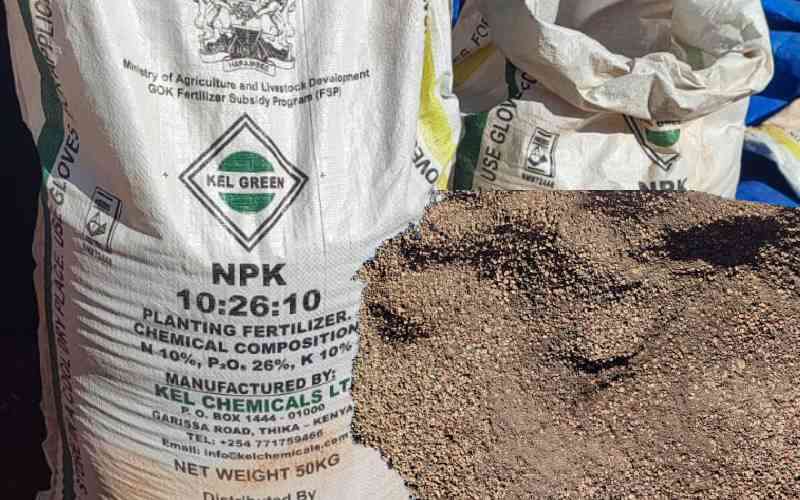Over a week ago, Cabinet Secretaries for Treasury and Agriculture hurriedly convened a press conference to update the nation on the “current national food situation.”
The country is currently steeped in a debilitating food crisis, a result of drought situation which has seen prices of basic foodstuff including cabbages, sukumawiki, potatoes, rice and tomatoes, go through the roof. Already, President Uhuru Kenyatta has declared drought a national disaster.
Thus, reporters warmed up to this impromptu conference. At Treasury Building, the two senior Government officials kept journalists waiting for 30 minutes. If the reporters were impatient, they never showed it. Finally, Henry Rotich (CS Treasury) and Willy Bett (CS Agriculture) walked in, flanked by four other individuals. One of them, Nick Hutchinson, was better known to most of the agriculture reporters in the room.
Mr Hutchinson is the chairman of the Kenya Association of Millers (KAM) and the CEO of Unga Group, a prominent milling company in Kenya. It was largely assumed that the other individuals were also millers.
Running empty
Rotich was the first to speak. And he went straight to the point. He had good news. In less than a week, the price of a two-kilogramme packet of maize would fall to Sh115 from a high of Sh153. The conference was on ‘maize’ not ‘food.’
In his budget speech, Rotich said he had taken all the necessary steps to ensure the price of unga came down. That included removing the 16 per cent value-added tax (VAT) on all inputs used to make maize-flour besides allowing duty-free importation of white maize from Mexico.
Barely three days after his budget speech at the floor of National Assembly on March 30, Rotich moved swiftly to gazette amendments to the Value Added Tax, 2013 which would actualise these ugali-saving regulations. Kenyans, who looked like they were on the verge of implosion due to the rising cost of unga, could now take it easy— or so Mr Rotich seemed to say.
Maize is a livewire in Kenya. Mr Rotich and the Government know this. In the end, the August elections might be hinged on the availability of maize rather than the completion of a Sh327 billion modern railway line. But the skies have refused to open, and the country’s silos are running empty of this critical cereal used to make ugali, Kenya’s staple food.
On average, Kenya produces 40 million 90-kilogramme bags of maize annually, and per capita consumption of the cereal is around 90 kilogrammes (or one bag of maize).
A study by Tegemeo Institute found that within the cereal food group, the poor, medium and rich households allocated 83, 70 and 52 per cent of their cereal budget to maize flour. This compared poorly to what they spent on wheat and rice. The three income groups allocated 7, 16 and 25 per cent to wheat flour respectively and to rice, 4, 10 and 20 per cent respectively.
Ugali is to Kenyans what bread is to the French. And so, it was not surprising that when the country ran short of maize in 2011 following erratic rains, some people threatened to mobilise hungry and angry Kenyans under the banner of Unga revolution.
In the unlikely event that unga revolution would have materialised, it would not have been fundamentally different from the French Revolution which was ignited by scarcity of bread. Indeed, the price of unga has been so emotive that it has not only been a powerful catchphrase during election campaigns, but has also humbled or tainted the reputation of politicians.
In May 1966, following allegations of “unfairness, inefficiency, corruption and black marketing in the distribution and marketing of maize throughout Kenya,” an inquest titled “The Report of the Maize Commission of Inquiry”, pushed for the suspension of Paul Ngei, a powerful minister and also one of the famous Kapenguria Six who were detained with Mze Jomo Kenyatta.
Another maize scandal would resurface 44 years later in 2010, this time dragging in the name of the then Minister for Agriculture, William Ruto, now the Deputy President. Mr Ruto, refused to resign over the allegations that thousands of bags of maize from the Government’s strategic reserve might have been inappropriately allocated.
Stay informed. Subscribe to our newsletter
The name of the then Prime Minister Raila Odinga would also be dragged in the scandal, with Permanent Secretary Mohamed Isahakia and Principal Secretary/chief of staff Caroli Omondi, both from the office of the Prime Minister, adversely mentioned in an audit report that also recommended for investigations into their conduct.
Tampering with Kenya’s demand-supply matrix of maize is akin to pouring water on a livewire. High cost of fertiliser or seed, drought, diseases, brokers and increased intake of the grain by livestock are some of the factors that have occasionally tinkered with this sensitive equation, increasing the social and political temperatures of the country.
Currently, an unyielding drought, which started with spasmodic short rains in October last year, depressed harvests of maize. Tanzania and Uganda, countries that Kenya turns to plug its deficit, have also been ravaged by the drought that has also depressed their harvests.
There are also fears that the long rains expected between March and April might not be adequate. An invasion of maize plantation by armyworms only makes our food security situation worse.
And even as the Government raids its cash reserve, splurging it on the importation of a food crop that would ordinarily be produced locally, it is convinced that farmers and traders have hoarded millions of bags, thus creating artificial shortages.
There are also fears that despite being offered tax relief, millers might not be persuaded to bring down the cost of maize flour. The Government has already released 750,000 bags of the grain at a subsidised cost of Sh3,000. However, there are reports that in one week, millers have taken up less than 300,000 bags even as the price of a two-kilogramme packet of maize flour continues to retail at a high of Sh153. However, some brands have cut prices to about Sh125.
Modern farming
And it seems, consumers now find themselves at the mercy of ruthless traders and an unpredictable Rainmaker. Joy Kiiru, an economics lecturer at the University of Nairobi, insists that the short-term solution lies squarely with the millers and wholesalers. “We are at the mercy of the millers and wholesalers. We need to tell them that for the love of the country; for the love of fellow Kenyans, understand that people are suffering,” said Dr Kiiru in a telephone interview.
And this, according to Kiiru, is akin to trying to convince a hungry predator not to go for an easy prey. Millers and traders, she said, have seen an opportunity to make “abnormal profits.”
Experts agree that the long-term solution lies in increasing the supply of maize by producing, distributing and consuming maize efficiently. “Widespread and intensive use of modern farming technologies (fertilisers, seed), improved extension effort, well-functioning input and output markets and irrigation all lead to improved maize production efficiency,” says Dr Dennis Otieno, research fellow, Tegemeo Institute, an agriculture think-tank affiliated to Egerton University.
Yet, our surest bet is not on increasing the supply of maize but its substitutes, especially other cereals such as wheat, rice, millet and others. But as they say old habits die hard.
When in 2004 the then Local Government minister Robinson Githae was asked his advice for starving Kenyans, he asked them to consider changing their diets to even rat meat. The sentiment was received with revulsion and indignation in the same fashion French Queen Marie Antoinette’s sentiments that the protesting French peasants should take cake instead if there was no bread.
Experts agree that changing our dietary habits is the surest path to revamping Kenya’s food security situation. Our obsession with maize has made Kenyans lag behind not only in terms of calorie intake, but also in terms of nutrition. United Nation’s Food and Agricultural Organisation (FAO) says that cereals, including maize, are the most important food source for human consumption. But depending on maize alone has not served as well.
According to Hutchinson, the trend around the world is that as an economy grows, people move away from maize to wheat. And for good reason, wheat has superior calorific and nutritional value than maize and many other cereals. Although most calories are a critical source of energy, some are a better source of protein as well. Maize, however, is not.
With 32.1 per cent protein, common maize lags behind virtually all the other cereals in terms of protein richness. Wheat (38.7 per cent), sorghum (32.5 per cent), rice (79.3 per cent), and finger millet (35.7 per cent) have superior protein value than maize.
But wheat is also good for feeding the country because if well stored, it can last for as long as six to eight years.
 The Standard Group Plc is a
multi-media organization with investments in media platforms spanning newspaper
print operations, television, radio broadcasting, digital and online services. The
Standard Group is recognized as a leading multi-media house in Kenya with a key
influence in matters of national and international interest.
The Standard Group Plc is a
multi-media organization with investments in media platforms spanning newspaper
print operations, television, radio broadcasting, digital and online services. The
Standard Group is recognized as a leading multi-media house in Kenya with a key
influence in matters of national and international interest.
 The Standard Group Plc is a
multi-media organization with investments in media platforms spanning newspaper
print operations, television, radio broadcasting, digital and online services. The
Standard Group is recognized as a leading multi-media house in Kenya with a key
influence in matters of national and international interest.
The Standard Group Plc is a
multi-media organization with investments in media platforms spanning newspaper
print operations, television, radio broadcasting, digital and online services. The
Standard Group is recognized as a leading multi-media house in Kenya with a key
influence in matters of national and international interest.








